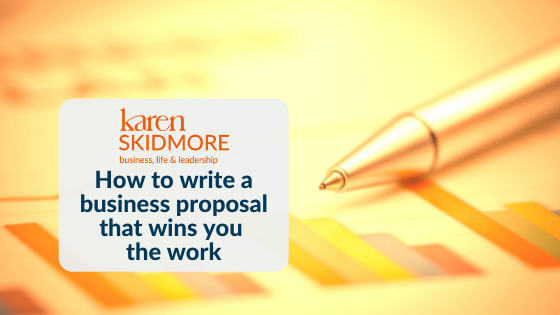“Send me a proposal”
When you’re ending a great sales call with your ideal client, these are the words you want to hear. You’re excited. They’re excited. You both just want to get started on working together.
So why do so many of us grapple with writing a business proposal that will take us over the line and onto the sale?
Perhaps it’s the lack of ‘fun’ associated with pulling the proposal together. Perhaps it’s the ‘not knowing what to write’. Sometimes it’s the fact that you’re so busy, you don’t have the headspace to write one out and you’re in danger of losing the work because your client moves on to another supplier.
Regardless, this is simply the time for you to take the relationship to the next level, stand out from the crowd and signpost the way forward in a clear document that confirms everything that has been discussed.
And the sooner you get a standard process set up for writing and sending out a proposal, the easier it will be going forward for all your future proposals.
Back to basics: the purpose of a proposal
The proposal is created to bring together in one place all that has been discussed. It means it can be shared across the decision-making team (if there is one) and used to benchmark alongside other options.
It outlines who you are, gives your take on the issues facing the client-in-waiting, how you would address them and what the result could be.
On a practical level, it also outlines the cost, the timescale and the key deliverables.
It gathers it all together. And that’s a key point.
The proposal is not the time to introduce something new. There should be no shocks or surprises.
What you need to know before you start
Before you put pen to paper or finger to keyboard, make sure you actually want to submit a proposal.
Obvious, maybe – but don’t get sucked into proposal writing if there’s any doubt you don’t want the work, it doesn’t fit with you strategically, you can’t deliver within the budget or you think a decision has been already made and you’re simply making up the numbers.
Also, decide whether a full proposal is needed. It isn’t always. A simple follow-up email summarising the sales conversation and outlining the fee, the deliverables, and next steps with a contract with business terms may suffice.
If you do want to prepare a longer proposal, here’s a quick checklist of the information you need before you get started. Do you know:
- The issues the client is looking to address?
- The budget they have to spend?
- The timescales they are working to and when a decision will be made?
- Who is making the decision (if it’s not the person you’ve been talking to, you may need to add in more information)?
- The criteria they are using to assess the proposals they receive?
The structure
Keeping these questions in mind will help you structure your proposal in a logical way, explain your ideas with clarity and ensure that everything you include is relevant to the would-be client’s needs.
Some clients provide guidelines as to what to include – and then you need to stick to those. But some don’t. If you’re looking for a structure, here’s a solid outline to use.
First, start with the client situation
Don’t jump right in with the proposed solution. This isn’t about you – it’s about them.
Use this section to outline your understanding of the issues they’re facing, based on the discussions you’ve already had. Use the words and language they use.
Show that you understand the impact it’s having on them and the business (if it is a business) and the pain or stress it‘s causing them financially, operationally or personally.
Get them to imagine how things will be better from working with you. Have in mind their desired outcome – and what success will mean for them. In short – and unashamedly taking one of Stephen Covey’s 7 Habits of Highly Effective People – begin with the end in mind.
Remember to reinforce that you’re on the same page. Show that your approach to ways of working and values align – and sow the seeds of a valuable relationship built on trust.
Once you’ve done that, the next bit follows like night follows day.
Outline your solution
Now frame your business as a solution to the current situation or the desired place. Avoid the long list of features – and focus on the benefits and the difference they will make.
Clarity is important here. You need to avoid jargon, get the message across succinctly and articulate where they are heading.
It’s easy to avoid mentioning something that you don’t offer but is something they are wanting. Work out how you can address this rather than ignoring it.
Map out how they can do business with you
This is all about deliverables, timescales and process.
Take them through the steps to show how working with you will map out. Be clear on who does what and when, and what outcome they can expect.
This shows you’ve done the thinking, you’re straightforward to work with and you follow a clear framework.
Include a plan if you can but not avoid too much detail other than the next three to five steps. It’s key to make the client feel comfortable and confident about what happens next.
The price
In your proposal, be clear on price – and what is and is not included – and, of course, frame it as an investment rather than a spend.
This hopefully won’t be the first time that you have talked about the price, but this can be a good opportunity to offer pricing options – probably no more than three – to help with negotiations if needed.
And, make it clear that your proposed fee is only valid for a limited time period. This is often missed and with it in place, it allows you to have a genuine follow up reason if they don’t come back to in the time frame you expect them to.
About you
This section isn’t really about you, or the long and illustrious history of your business, how many you employ or who are the key team members. So, ditch the marketing messages.
Showcase what you have done for others via mini case studies and impactful quotes from grateful clients.
Where you can, choose case studies of clients with similar challenges, or sectors, or need. And, as a side point, when you first write and get approval of your case studies, write several versions focusing on different themes or angles so you get as much from the story as possible. Use well-tailored bios of those working on the proposed project.
Social proof carries a lot of weight with decision-makers and helps them imagine what it would be like to work with you.
The call to action
Round off your proposal – with more than a thank you.
Your call to action (CTA) should be a trigger to accept or decline the proposal along with details of what will happen once they accept.
One suggestion is to make this simple with auto-signature software (Adobe Acrobat Sign, DocuSign or HelloSign). But be careful to test this with your audience – this ‘hands off’ automated approach may not work for some types of business.
But as long as there is an active CTA, you have several options:
- Add a deadline: remind them that the price is only valid for X days (bearing in mind this may fall on stony ground with corporate clients who will work to their own timeline, it still gives you a valid reason for following up if contact goes cold)
- Reiterate the benefits (for example, “We’re looking forward to helping drive your business growth. Let’s get started.”)
- Let them know you will contact them within X days to arrange a time to discuss the proposal (between 3 and 5 working days keeps momentum whilst still allowing your prospect the space to reflect and review their options.)
Whatever you do, make it easy for them: make your email address a live link; make sure your phone number is clearly visible.
Include your terms and conditions
Always, always, always include your business terms and conditions within the proposal, either at the back or as an addendum.
Again, this is missed by too many people and can create potentially difficult conversations if work is postponed or cancelled after the proposal has been accepted.
Give them a shortcut
Ideally your proposal will always be read in its entirety. But life isn’t always like that.
Think about including a one-page summary which includes the key points over and above the price, time, milestone, resources, and deliverables in case the client decides to pull out the key facts and to benchmark you against competitive proposals. It means your key arguments will remain intact.
Make it look like you
Proposals are about substance. But they need to be presented well and look good. Develop a ‘look’ for your proposals that reflects your own brand. It’s not about making it look like a sales brochure: too much ‘design’ can put people off. However, a plain Word document in 10pt Arial will seem like you can’t be bothered.
Does it need to be a Word document? Many proposals now are created as a PowerPoint slide deck.
Depending on what you’re selling, design will have greater or less importance but make sure that there’s a connection between your design and the words you use to talk about your business. If you can, invest in some key graphics or design elements in your brand colours and brand style. Once you have a template that works for you, this investment will pay dividends in the future.
It’s a good idea to build up a library of texts, images, statistics, boilerplate words, photos, bios, product and service descriptions to make for easier proposal writing. But never just cut and paste into different proposals without some tweaking. That’s the fast route to a vanilla proposal.
The final check
Before you hit ‘Send’, do a final check:
- You’ve followed their template or structure – and included everything they’ve asked for (not just what you think is needed).
- What you’ve included addresses their needs and proposes a solution that’s clear to understand and easy to read.
- You’ve broken up long sentences and included headings and short paragraphs to make the proposal easier on the eye.
- You’ve used positive language: talking less about their ‘problem’ or ‘challenge’ and more about their desired endpoint to imagine a better future.
- Names of people, businesses, places, products and services are correctly spelled.
- There are no typos or errors. Use in-built spell checkers and run software extensions like Grammarly to help, but nothing beats printing it off for a good read through with human eyes. Check the headers and footers as well as the body copy.
- There are no rogue company names in the ‘properties’ tab of the document or in the footer. It happens when you use a previous proposal for a different client as a template for the next. I have seen this – and it’s embarrassing!
You’re ready to send
Cover email
Quite simply, the cover email or letter is a must. It needs to be brief, personal and authentic and introduce what they are about to read: outlining their situation, your solution and the next steps to take.
They need to know you’ve listened, understood, and that you have a solution.
How to send
Proposal software (e.g. Panda Doc or Better Proposals) may be something you think of getting hold of. Easy to use, it can create a beautiful journey for the client. It lets you know when the reader opens, works through and shares the proposal – and you can track how the reader reads and pauses through the document. It also provides a simple way to get started by enabling a signature acceptance of the proposal.
But such systems are not for everyone.
It’s usually fee-based and doesn’t always fit comfortably within the buying process of a client, or your onboarding process.
What happens next?
Always follow up – without fail.
Get in touch within a few days to check that they have received the proposal and to check if there are any questions. Don’t be one of those companies that doesn’t follow up proposals and just sends them into an empty void.
If it’s a ‘yes’ – congratulations! And, if it’s a ‘no’, book a review call and learn why you didn’t win the business.
A final thought
However you design and write your new business proposals, there’s one overriding principle: it’s all about the client.
Focus on making the connection for them between what you offer and what they need, get the deliverables and the price right, and show them you know what you’re doing.
In short, make it easy for them to say yes.
This weeks’ article has been written by Lois Dabrowski . Lois is a specialist B2B marketer working with companies who sell into HR, talent and L&D leaders.
. Lois is a specialist B2B marketer working with companies who sell into HR, talent and L&D leaders.
Get in touch and get help to create business proposals that will win you work by dropping her an email [email protected] or connecting with her on LinkedIn.







